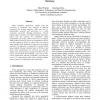Free Online Productivity Tools
i2Speak
i2Symbol
i2OCR
iTex2Img
iWeb2Print
iWeb2Shot
i2Type
iPdf2Split
iPdf2Merge
i2Bopomofo
i2Arabic
i2Style
i2Image
i2PDF
iLatex2Rtf
Sci2ools
SSDBM
2003
IEEE
2003
IEEE
Efficient Update and Retrieval of Objects in a Multiresolution Geospatial Database
Many emerging applications benefit from the extraction of geospatial data specified at different resolutions for viewing purposes. Data must also be topologically accurate and up-to-date as it often represents real-world changing phenomena. Current multiresolution schemes use complex opaque data types, which limit the capacity for in-database object manipulation. By using z-values and B+ trees to support multiresolution retrieval, objects are fragmented in such a way that updates to objects or object parts are executed using standard SQL statements as opposed to procedural functions. Our approach is compared to a current model, using complex data types indexed under a 3D R-tree, and shows better performance for retrieval over realistic window sizes and data loads. Updates with the R-tree are slower and preclude the feasibility of its use in timecritical applications whereas, predictably, projecting the issue to a 1-dimensional index allows constant updates using z-values to be impleme...
| Added | 05 Jul 2010 |
| Updated | 05 Jul 2010 |
| Type | Conference |
| Year | 2003 |
| Where | SSDBM |
| Authors | Sham Prasher, Xiaofang Zhou |
Comments (0)

